Art Deco Jewelry
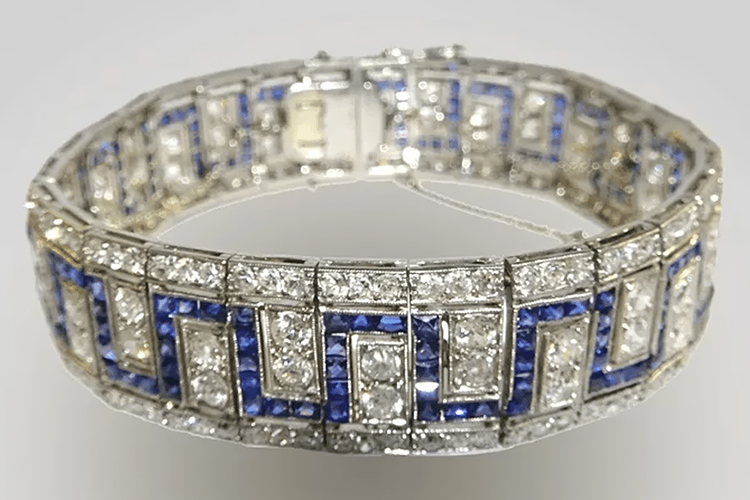
The Jazz Age, The Charleston, Flappers, Tutankhamun, Cubism, Graphic Design, Airplanes, Automobiles, Industrialism, Russe Ballet, “Exposition Internationale des Arts Décoratifs et Industrials Modernes”, Prohibition, Cocktails and Speakeasies defined the Art Deco era.
When: Art Deco, which encompasses all the decorative arts including jewelry was from 1920 to 1939. It began to manifest a couple of years before World War I and took off when the war ended, building and evolving until World War II came along. Some jewelry historians refer to 1930s Art Deco as Art Moderne or Modernism. The era is also known as the “style between the wars”. Art Deco was fully launched in 1925 at the Paris “Exposition Internationale des Arts Decoratifs et Industrials Modernes” where this new look was on full display.
Famous Makers: Boucheron, Black Starr & Frost, Cartier, Chaumet, Jean Deprès, Georges & Jean Fouquet, Lalique, LaCloche, Mauboussin, Raymond Templier, Tiffany & Co., Van Cleef & Arpels, Raymond Yard
Motifs: Egyptian, Asian, African and Native American Art, Geometric Forms, Flora and Fauna, Architecture, Tassels
The Look: 1920s Art Deco: Flat, Linear, Symmetrical, Geometric, White on White, Black and White, Bold Color, Long Necklaces. 1930s Art Deco: Bigger, Wider Bracelets; Convertible Jewelry, Rounded Scrolling Forms, Bib and Collar Necklaces
Materials: Diamonds, Rubies, Sapphires, Emeralds, Rock Crystal, Onyx, Lapis, Coral, Pearls, Carved Gems, Cabochon Gems, Enamel, Lacquer, Platinum, White Gold, Yellow Gold
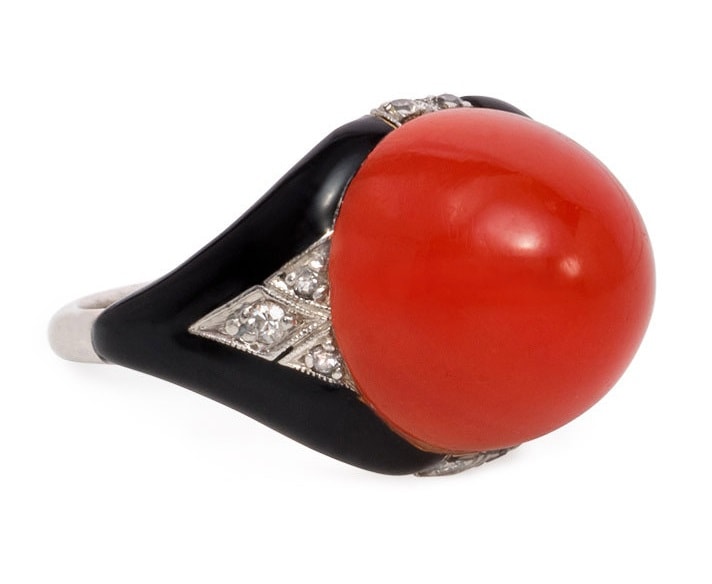
Coral, black enamel, diamond, gold and platinum ring from Kentshire Galleries, LTD.
The 1920s, often referred to as the “Roaring 20s” was a time of great prosperity and innovation. World War I had just ended bringing major societal changes along with it. In particular, the role of women in society had dramatically changed by the early 1920s. During the war years women went to work holding down the jobs that men had held before leaving to join the war effort. Wardrobe changes were a necessity. Working women ditched their corsets, raised their hemlines and shortened their hair so they could move more easily. In the U.S. some women were further empowered when they won the right to vote in 1920. After enduring the hardships of a world war and a global flu pandemic during the previous few years, by the early 1920s people were ready to dress-up and party.
Prohibition laws from 1920 until their repeal in 1933 made the sale and consumption of liquor illegal in the U.S. The law didn’t stop people from imbibing and the speakeasy launched – secret rooms where revelers would drink hidden away from the world. Flappers — the “it” girls of the era — danced the Charleston in speakeasies and scandalously wore hemlines raised up to their knees, seamed stockings, sleeveless shift dresses, sleek bobbed hair and most shocking of all they wore lipstick, rouged their cheeks and smoked cigarettes. Cigarette holders, cases and minaudières adorned with gems were all part of the glamourous look of the era. And of course every outfit was accessorized with sparkling jewelry.
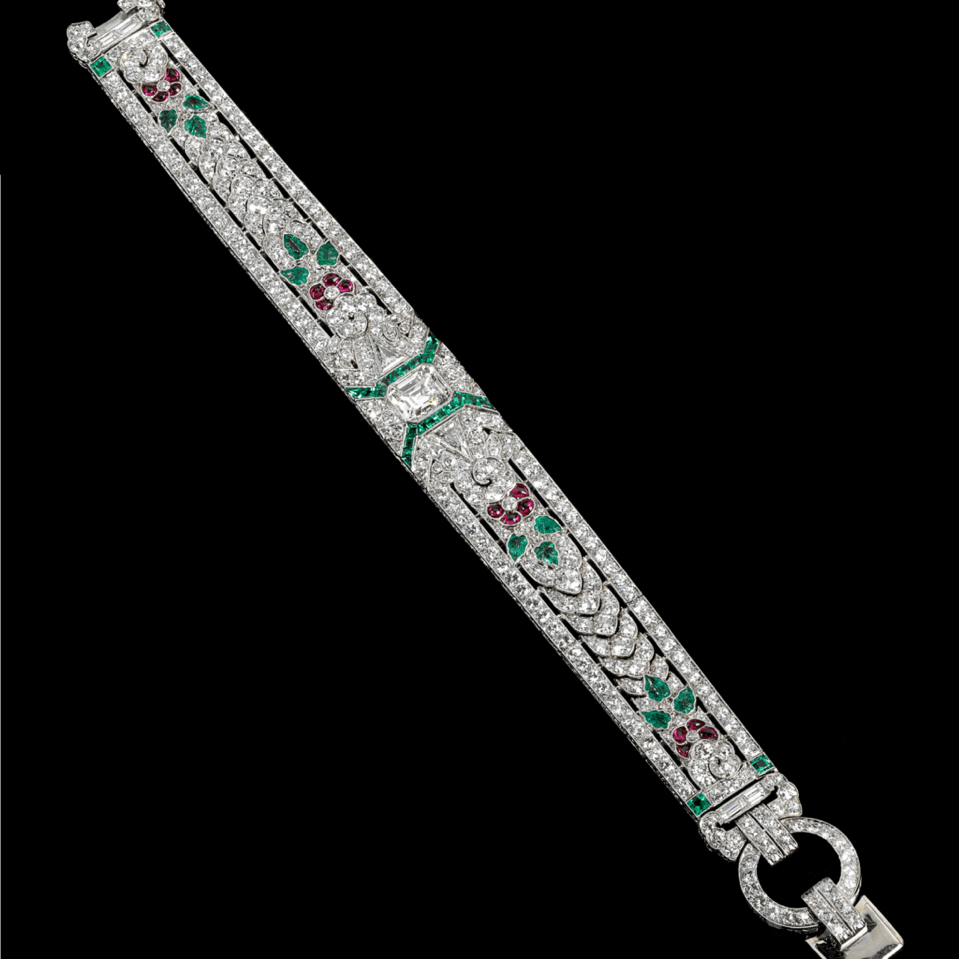
Diamond, cabochon ruby, carved emerald and platinum bracelet by Oscar Heyman Bros., circa 1928, from Kathryn Bonanno Inc.
During the Art Deco era, jewelry design was pared down to its most basic elements creating sleek silhouettes that were easy to wear. It was an embracing of machination and the industrialism that was spreading quickly through the world during that time. The white on white look of diamonds and platinum continued from the Edwardian era, but the jewelry became geometric and streamlined and was often punctuated with patterns created from the use of black onyx, black enamel, ruby, sapphire or emerald. Platinum continued its streak of popularity. Diamonds remained a favorite in the 1920s and 1930s, with pavé becoming an important design element. There were also some new advances in diamond cutting and with that came new diamond shapes that complemented the geometry of jewelry designs – including the Asscher cut and the baguette.
Sautoirs — a long necklace comprised of strands of pearls or colored gemstones, often with a tassel of pearls or pearl and colored gemstone beads — swung from the necks of fashionable women. Cultured pearl production ramped up in the early 1920s making the gems more available and their popularity soared. Flappers wore long ropes of pearls — often knotted — sometimes even letting them dangle chicly down the back of a low cut dress.
Shorter hair made statement earrings an important jewel, with long, linear earrings taking centerstage. The style also worked well with the straight, drop waist dresses of the 1920s.
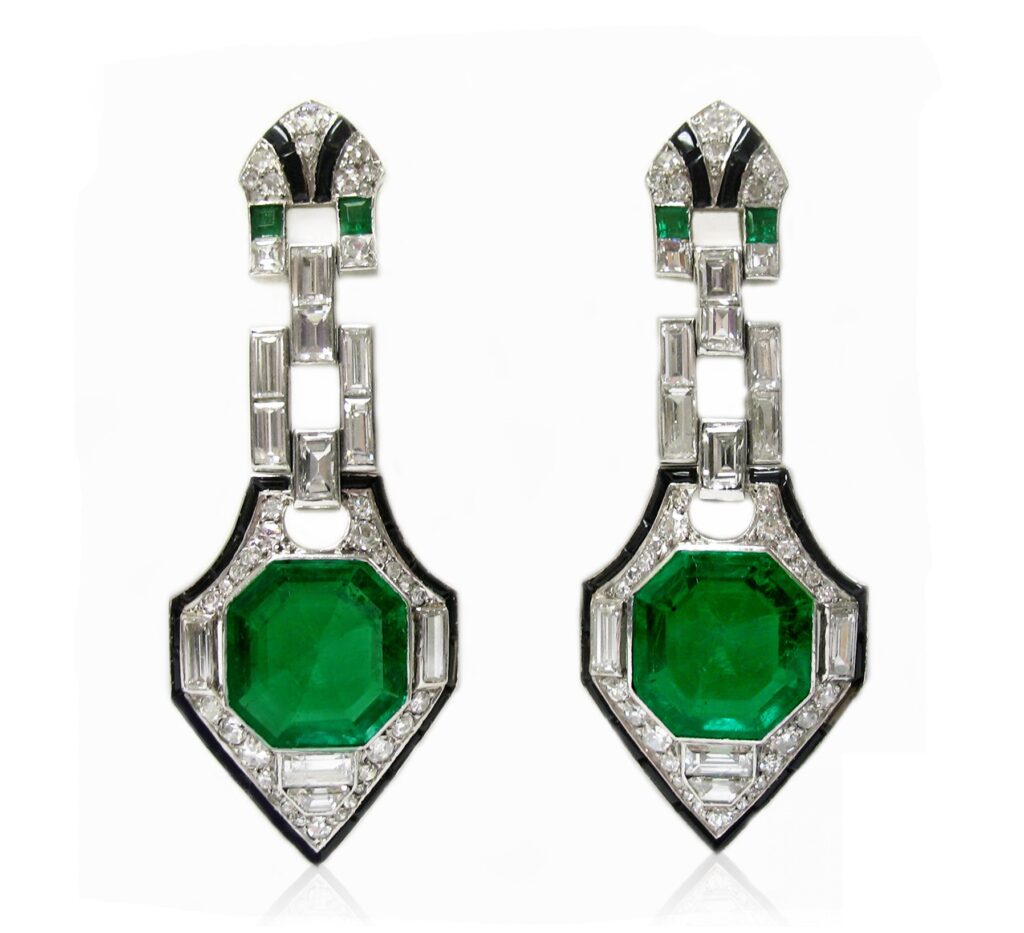
Emerald, diamond, enamel and platinum earrings, circa 1925, from J.&S.S. DeYoung.
Bracelets were a favorite in the Art Deco era and were often worn over elbow length gloves and stacked together to create maximum high voltage glamour. Diamonds were the base of these flat, linear bracelets which were embellished with colored gemstones that broke up the whiteness of the diamonds while at the same time outlining and amplifying the geometric forms that were a key look of the era. Wider bracelets were often used to tell the stories of exotic places and were embellished with birds, florals and Egyptian motifs, which had become popular with the discovery and opening of King Tutankhamun’s tomb in 1922.
The Maharajahs of India also influenced jewelry design in the 1920s as they took carved rubies, emeralds and sapphires to European jewelers and had them turned into extravagant jewels. Cartier was the leader in this colorful look dubbed tutti-frutti.
Rings followed a similar pattern of geometric shapes covered in diamonds with a line of colored gemstones that defined the symmetry of the design. Multiple rings were worn at the same time often with a big center stone and like bracelets, rings were worn on top of gloves. Brooches and dress clips were worn primarily during the day and they were attached to everything from hats, collars and coat lapels to shoes.
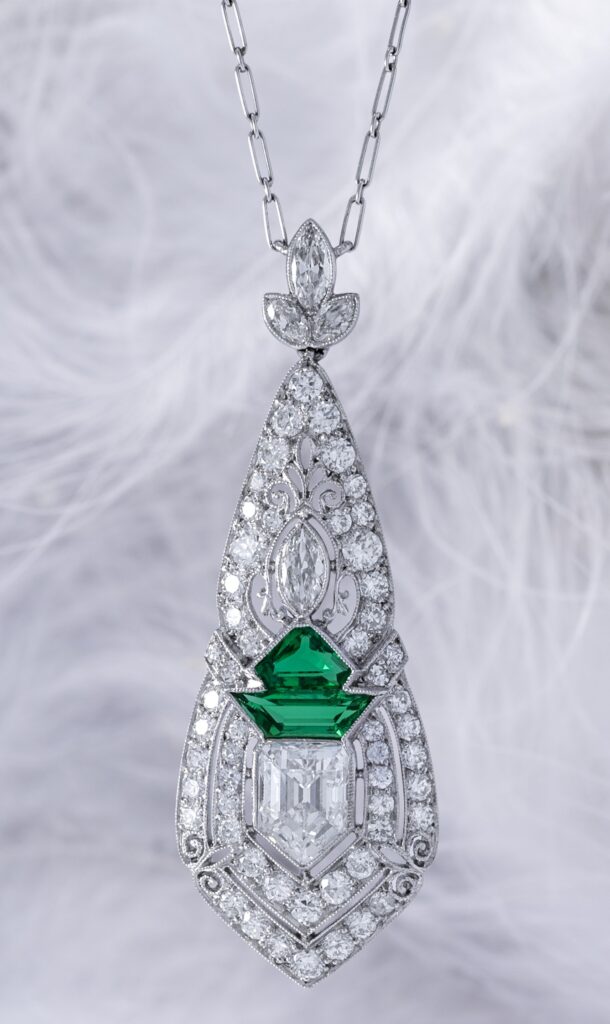
Emerald, diamond and platinum necklace, marked Tiffany & Co., from J.S. Fearnley.
The Bandeau was an important part of jewelry fashion in the 1920s. A headband worn on the forehead and generally crafted from diamonds did double duty by converting to a necklace, bracelets, brooch and/or dress clips.
In October 1929, the stock market collapsed causing the world to fall into an economic depression that left the global economy in tatters. While millions were unemployed and standing in line at soup kitchens, there were still plenty of people with money and the glamour of the Art Deco era continued, but the style evolved during the 1930s.
Sleek suits, silk and satin gowns that clung to a woman’s figure, long furs and lots of jewelry defined the decade. Hemlines dropped, hair was longer and worn up and the mood was subdued. Prohibition ended and cocktail parties came out in the open, which continued the trend of a big stone ring that looked so glamorous on a hand holding a champagne glass.
Platinum was still the desired metal, but 18-karat white gold was used as a less expensive alternative. Necklaces changed, they were now collars and bibs with some rounding and scrolling beginning to appear that broke up the flat geometric style that had dominated in previous years. Necklaces in the 1930s were often constructed to come apart as two dress clips that could also be put together to wear as one brooch. While brooches and dress clips were highly coveted in the 1920s, they surged in popularity in the 1930s. Suit lapels were the perfect backdrop for a sophisticated brooch while dress clips on each side of a party dress or gown twinkled flirtatiously at night.
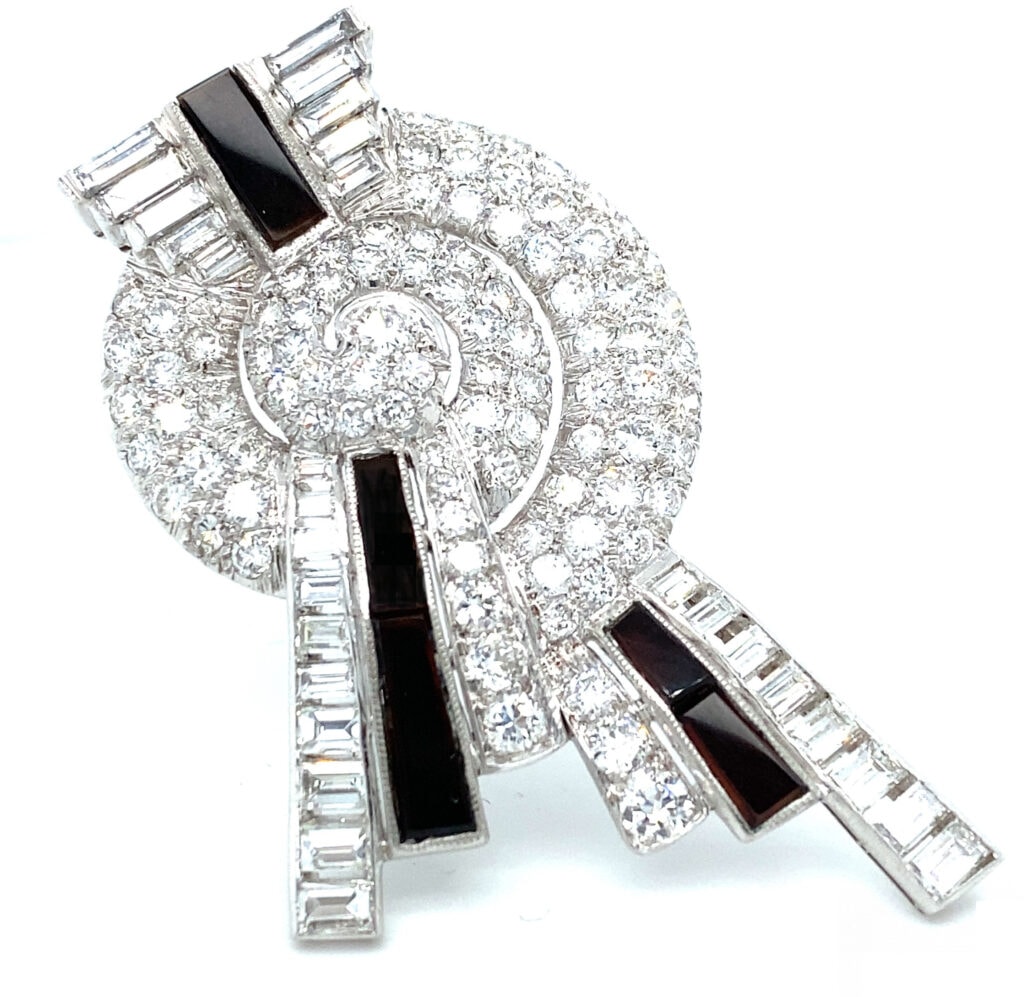
Diamond, onyx and platinum, circa 1930s, brooch from L’Epoque d’Or.
Earrings also changed during the 1930s, shortening from long drops to scrolling forms that framed the face. Some earrings even had detachable components. Bracelets became wider and curves and rounded forms began to appear by the end of the 1930s.
The glamourous parties and free-wheeling lifestyle of the Art Deco era ended in 1939 when World War II exploded.
You can find the Art Deco jewelry featured in this article on The Jewelers Circle.
Source: International Antique Jewelers Association, www.iaja.com. Top image: Sapphire, diamond and platinum bracelet, circa 1925, from Ernst Faerber.